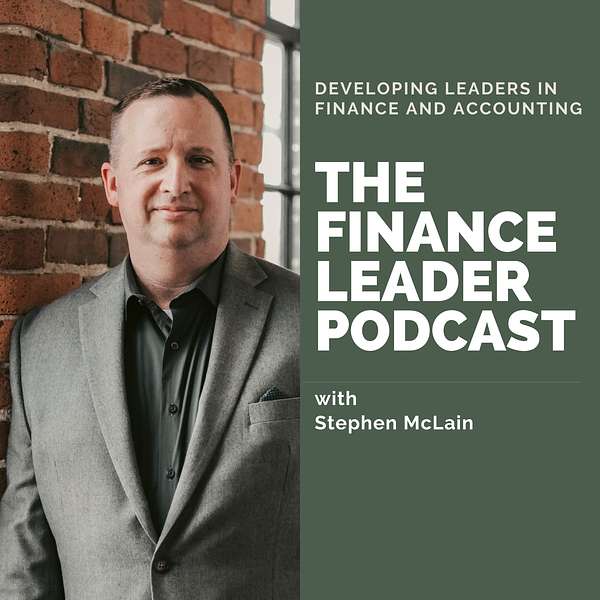
The Finance Leader Podcast
Leadership development can lead to greater promotion potential. This podcast is hosted by Stephen McLain, a U.S. Army-Retired Finance Officer. After retirement, Stephen transitioned to working as a Business Consultant in Corporate Finance and Accounting. Topics will be dedicated to leadership and strategic mindset development for Finance and Accounting professionals, where we will focus on the four key Finance Leader responsibilities: 1) influence, 2) developing our team, 3) achieving results, and 4) seeing the future . Please listen to the trailer so you can check it out. Thank you!
The Finance Leader Podcast
Bonus Episode 62: Making Sense of Numbers: Simple Communication in Finance is Best
Ever feel overwhelmed by the sheer volume of numbers and metrics in finance? Imagine how your audience feels! Join me as I briefly explain the art of providing high-value, simple yet powerful financial analysis. Guaranteeing clarity, I will guide you to focus on the fundamentals, stripping back unnecessary complexity and enhancing the impact of your communication.
We all know how counterproductive overloading information can be. It's high time we learned to deliver top-notch analysis in fewer words. Listen in as I share insights into understanding your audience, answering only what's asked, and eliminating anything that doesn't add value.
Please connect with me on:
1. Instagram: stephen.mclain
2. Twitter: smclainiii
3. Facebook: stephenmclainconsultant
4. LinkedIn: stephenjmclainiii
For more resources, please visit Finance Leader Academy: financeleaderacademy.com.
- On the website, you can download the Become a Finance Leader Guide. You can use this guide to build your Finance Leadership skills so you can help senior leaders develop and execute the strategy.
- I also offer a course, Advance Your Finance and Accounting Career: Developing a Promotion Strategy that Sets You Apart.
Hi, this is Stephen McLain of the Finance Leader Podcast. This is Bonus Episode Number 62. Well, good day to you wherever you are listening from. I appreciate your dedication to growing your Finance Leadership skills so that you can break out from the role you are currently performing and so that you can achieve your long-term goal. What have you been working on lately? Are you on a high visibility project that is making a difference? What positive impacts are you having? Are you growing any new skills or showing your future potential? I am excited for you to develop into an amazing Finance Leader. I know you can. I believe in you.
Stephen McLain:Today, I want to talk about providing more simple based but powerful analysis. Whatever we are working on, often we are trying to find one number or one set of numbers. if it's a projection, if you are pulling actual results, maybe it's a series of sales and margin numbers or traffic or something else that senior leaders need so they can evaluate performance, or maybe it is another set of relevant data. We are always being asked for analysis on data. Sometimes we have routine reports that are due daily, weekly and even monthly and quarterly, depending on what our senior leadership needs from us to do their jobs effectively, and we are always being asked to provide random requests for data and analysis. Senior leaders often don't have time to read excessive words or try to analyze your analysis, so you have to keep it simple. We don't want to confuse them or take excessive amount of time from them.
Stephen McLain:Your analysis should be easily understood in one read through. That is the first read through. Only It should be that easy. Keep your words few. Write out powerful analysis in as few words as possible and make simple charts and tables. We should not be overloading it, believing that more is impressive. Keep it simple and press by providing a key insight or a while moment. That's in the data. So let's discuss keeping your analysis easy to read. Here are a few suggestions so we can keep our analysis simple.
Stephen McLain:1. Focus on your audience. What does your audience need to help them with their job? It might be a key metric, or do they need a year-over-year comparison or a week-over-week or some other time comparison? Do they need an analysis by business unit or some other metric like the top five product margins? Know your audience so you can answer the task or request. 2. Answer only the question asked. What are you asked to provide? No more or no less than what you are being asked, unless there is a wow tie-in to something extra that might help answer why. We must be careful about over-sharing, because your audience can get lost in your analysis if it's excessive. 3. Delete anything that adds no value After your first draft review and remove anything that seems extra or distracts from your message because we don't want to confuse or frustrate your audience.
Stephen McLain:1. Open your own email where you provided 7 paragraphs of explanation along with 3 or 4 charts, when you could have provided high value analysis in one chart with only a few high powerful bullet statements. The excessive amount you provided can overwhelm an already busy senior leader. So keep it short but powerful. One page reports are great. A simple chart with 1-3 key bullets that provide key color analysis is great. More information often confuses people and makes you have to work even more to re-explain what you provided. The simple but powerful communicator will be respected and sought after. This is another great example of great leadership. We are not just sending loads of unorganized data, but relevant and value-added information for decision-making. This takes great skill and knowledge to perform correctly, and this is what finance leaders do every day. I hope you have a great rest of your week. Thank you for listening to the Finance Leader Podcast. Please visit financeleaderacademycom for more resources. And until next time, keep working on your goals, keep growing your leadership skills and take care of your team, because they will take care of you. Thank you.

